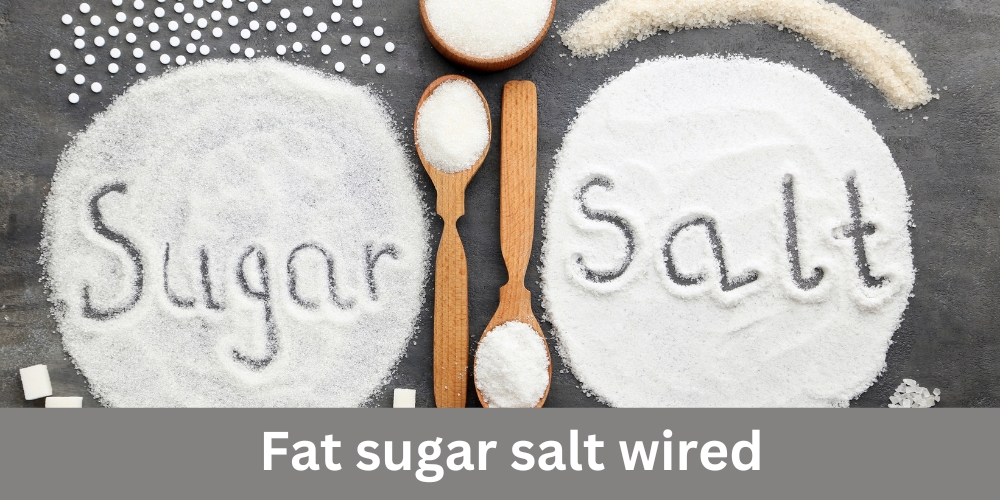Nowadays, going through a grocery shop is like navigating a maze of unhealthy and enticing options. Foods heavy in fat, sugar, and salt are stacked high on shelves to entice our palates and keep us returning for more. How did we get predisposed to such desires, and why are these chemicals so alluring? Let’s examine the science underlying our fascination with fat, sugar, and salt and discover why these foods firmly hold our diets. In this blog, we will talk about Fat, Sugar, & Salt wired combination.
The Fat, Sugar, and Salt Appetite: Evolutionary Benefits
Fat: The Ultimate Energy Source:
Compared to proteins and carbs, fat has more than twice the calories per gram, making it a dense energy source. Because high-fat foods supplied vital energy reserves during food scarcity, our ancestors evolved to crave them. Due to the persistence of this evolutionary feature, high-fat meals such as creamy desserts, fried snacks, and fatty meats are incredibly gratifying and challenging to resist.
Sugar: The Fast-Firing Substance
Our bodies quickly transform simple carbs like sugars into glucose, the primary energy source for our muscles and brain. Sweet foods, such as fruits, were an important source of fast energy and essential nutrients in prehistoric times. Our brains are designed to desire sweetness, which explains why sugary snacks like soda, candy, and baked goods are so appealing.
The Essential Mineral Salt

Maintaining fluid equilibrium, neuron function, and muscle contractions depend on salt or sodium. Since it was difficult to find salt in the wild, our ancestors evolved a taste for it to ensure they ate enough. Even now, salty snacks like chips, pretzels, and processed foods are especially addicting due to this innate desire.
The Challenge of Today
Origins of Evolution
Our deep-rooted evolutionary history is reflected in our desires for fat, sugar, and salt. When these substances were rare and necessary for survival, our ancestors had to search for them. This deep-rooted inclination has continued into the modern era, even though excess has replaced scarcity.
Foods in Process and Extreme Palatability:
Food producers have taken advantage of our innate needs by producing highly palatable foods, meaning they have a lot of fat, sugar, and salt combined to make them taste good. These pairings aim to achieve what’s known as the “bliss point,” which is the ideal ratio of these components that maximizes enjoyment and makes it difficult to stop eating. Imagine a chocolate-covered pretzel; it satisfies our cravings for sweetness, salt, and fat in just the right amounts.
Excessive consumption is having an impact on our well-being. Overindulgence in highly processed foods has been connected to several health problems, including depression, obesity, colorectal and breast cancer, and all-cause mortality. Determining how our food affects our health is incredibly challenging, and even the most casual statistician will tell you that correlation does not imply causation. Still, it does appear evident that eating an excessive amount of highly processed food is bad for humans.
Brain Chemistry and Addiction:
Dopamine is a neurotransmitter linked to pleasure and reward that is released when someone consumes foods heavy in fat, sugar, and salt. A similar feeling to that produced by addictive substances is created by this release in terms of enjoyment and contentment. Regular use of these foods can cause changes in brain chemistry over time, increasing cravings and making it harder to make healthier decisions.
Consequences for Health:
Overindulgence in Fat sugar salt wired has been connected to several health problems, including diabetes, heart disease, hypertension, and obesity. Because of their intense desires and the fact that these substances are commonly found in processed foods, many people find it difficult to cut back on their intake even after being aware of the risks.
Ending the Cycle
Consciously Consuming Food:
Mindful eating is one strategy to resist the allure of fat, sugar, and salt. This means being aware of what and how you eat, enjoying every meal, and identifying your body’s signals of hunger and fullness. You can make more deliberate food decisions and reduce mindless snacking by increasing your awareness of eating patterns.
Wholesome alternatives
Another tactic is finding healthier alternatives to your favorite high-fat, high-sugar, and high-salt foods. For instance, use fresh fruit instead of sweet snacks, lightly salted nuts instead of salty chips. And healthy fats like avocado or olive oil instead of butter or margarine.
Cooking at Home:

You have more control over the ingredients and quantity when you cook at home. Making meals from scratch will help you control your added sugar, fat, and salt, improving your diet’s overall health.
Education and Awareness:
A greater understanding of nutrition and the effects of fat, sugar, and salt on your health. It can enable you to choose healthier foods. You can also prevent overconsumption by reading food labels and being aware of the hidden origins of these components.
In summary
These components are (Fat sugar salt wired)incredibly alluring and challenging to resist. Because of the deep evolutionary roots of our desire for fat, sugar, and salts. But in the modern world of processed meals, this natural inclination can result in overindulgence and severe health hazards. By comprehending the reasons behind our cravings and implementing techniques to control our consumption. We can make more health-conscious decisions and end the vicious cycle of fat, sugar, and salt addiction.

